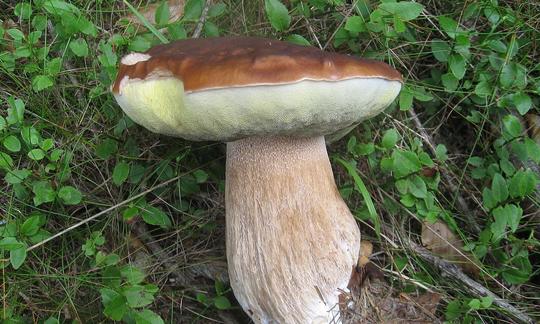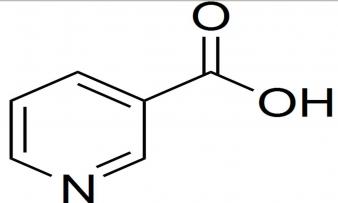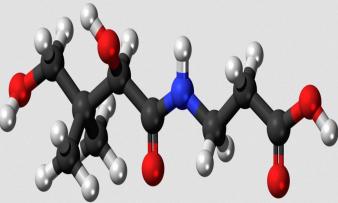Table of contents
The common porcini mushroom (or pine porcini) is an important edible mushroom. Cultivation of Boletus edulis is not yet possible, which is why it is collected. Nevertheless, it can be found in organic quality in stores.
Use in the kitchen When eaten
raw, the porcini mushroom has an intense, mushroomy to nutty taste that does not diminish significantly when cooked. Its tender bite also remains after cooking.
There are many different ways to prepare the common porcini mushroom: roast, steam, deep-fry, grill, braise and gratinate. It tastes great with all kinds of hearty (vegetarian and vegan) dishes. We show recipes for soups, broths (e.g. vegan mushroom and vegetable broth with carrots and celery ), as a filling in tortellini (e.g. vegan walnut tortellini with red wine and mushroom reduction ) or ravioli (e.g. vegan rawioli corners with porcini mushroom filling ). The porcini mushroom also goes well in omelettes, sauces, risotto and stews.
Briefly fried and refined with a little lemon juice , garlic and parsley , the porcini mushroom immediately enhances pasta dishes. It is also used for typical autumn dishes - often with other mushrooms (e.g. chanterelles , oyster mushrooms , king oyster mushrooms ) in a mushroom sauce served with spaetzle or dumplings. It is also recommended to use it to make antipasti. Briefly fry the caps of young porcini mushrooms and season with a little balsamic vinegar , salt andpepper .
When prepared simply, porcini mushrooms taste wonderfully authentic (seasoned with a little salt and pepper and herbs such as parsley, chives , thyme , marjoram , coriander ). If you like to experiment, we recommend adding a touch of nutmeg or a little ginger .
Before processing, each mushroom should be cleaned thoroughly with a brush or kitchen towel instead of washing it with water, as the absorption of water makes mushrooms spongy. Some large porcini mushrooms collected in the wild may have one or two stems infected with maggots. In this case, simply remove the stem and use the cap.
Can you eat porcini mushrooms raw? In general, you shouldn't eat mushrooms raw because they're hard to digest. But not all raw mushrooms are poisonous per se. In small quantities, very young porcini mushrooms, oyster mushrooms , king oyster mushrooms , shiitake mushrooms, truffles , enoki mushrooms and others can probably be edible. According to the German Mycological Society, cultivated mushrooms available in stores can also be eaten raw in small quantities, clean and fresh.16 However, they are not easy for everyone to digest and there is no scientific literature on the subject. Most of the time these are reports from experience, so you decide for yourself whether you want to try porcini mushrooms raw. If you consciously decide to eat common porcini mushrooms raw, you should slowly increase the amount you eat and experiment. However, it is important to know that small amounts of raw porcini mushrooms have not caused stomach pain. A well-known raw food recipe is porcini mushroom carpaccio.
Vegan recipe for porcini mushroom risotto
Ingredients (for 4 people): 400 g porcini mushrooms (raw), 300 g risotto rice , 1 onion , 2 garlic cloves , 150 ml vegan cream (e.g. oat cream ), 150 ml white wine (or water), 350 ml vegetable stock , 2 tbsp yeast flakes , a little rapeseed oil , salt and pepper.
Preparation: Peel and chop the onion and garlic finely. Brush the porcini mushrooms and cut into small pieces. In a heated pan, fry the onion with a little rapeseed oil until translucent. Add the porcini mushrooms and garlic and fry. Season with salt and pepper. Add the risotto rice and sauté briefly. Deglaze with white wine, simmer a little and then add the vegetable stock. Stir in the yeast flakes and vegan cream and simmer uncovered over a low heat for approx. 20 minutes. Add a little water if necessary. As soon as the rice has the desired consistency, season with salt and pepper and serve the vegan porcini mushroom risotto.
Vegan recipes with porcini mushrooms (raw) can be found under the note: " Recipes that have the most of this ingredient ".
| Not only vegans or vegetarians should read this: Vegans often eat unhealthily. Avoidable nutritional mistakes . |
Purchasing - Storage
Porcini mushrooms cannot be cultivated. Therefore, the supply in the trade depends on the success of the collectors. Some supermarkets such as Coop and Migros offer fresh porcini mushrooms (raw) in the autumn months, often in organic quality (organic). Fresh common porcini mushrooms can often also be ordered online.
Many supermarkets (e.g. Denner , Volg , Spar , Billa , Lidl , Aldi , Rewe , Edeka , Hofer etc.) and organic supermarkets (e.g. Alnatura , Denn's Biomarkt ) rarely or never have raw porcini mushrooms on offer. However, well-stocked stores sell frozen porcini mushrooms or dried porcini mushrooms all year round.
The availability of raw porcini mushrooms in the supermarkets mentioned varies depending on the size of the store, catchment area, etc. If you are interested, click on our recorded food prices for the DA-CH countries (above under the ingredient image). There you will find current prices from various supermarkets and their price development.
Found in the wild
The common porcini mushroom is found in temperate latitudes in the northern hemisphere. It grows in moss-rich coniferous, mixed and deciduous forests. The common porcini mushroom, also known as the pine porcini mushroom, grows from May to October. 3 The main season for collectors is September and October . 2 As this mushroom is one of the most sought-after and most collected edible mushrooms, there are restrictions on collecting . Germany, Austria and Switzerland have (partially) prescribed maximum amounts for collecting and local collection bans. 14 There is a possibility of confusion, without negative effects, with other edible porcini mushroom species such as the summer porcini mushroom ( Boletus reticulatus ) or the pine porcini mushroom ( Boletus pinophilus ). 13
Does the porcini mushroom form a symbiotic relationship? A common porcini mushroom is a mycorrhizal fungus, which means that it connects itself underground with the roots of plants and thus forms a symbiotic relationship with them that is beneficial for both partners. 1 Common partners for mycorrhizae are spruces, beeches, oaks and pines, which is why they are often found under these trees. 2
Storage tips
Fresh porcini mushrooms should be stored in a dry, cool place. The vegetable compartment of the refrigerator or a dry cellar compartment is ideal for this. The mushrooms should not be placed on top of each other, otherwise pressure marks will form, which will rot more quickly. Raw porcini mushrooms can be kept for up to three days. Fresh mushrooms can also be frozen, but this will reduce some of the flavor. Before freezing, blanch the chopped mushrooms in boiling water for about three minutes. Frozen porcini mushrooms can be processed without defrosting.
Can you dry porcini mushrooms? Porcini mushrooms are easy to dry. To do this, clean the porcini mushrooms, cut them into thin slices, place them on a baking tray and dry them for 5-6 hours with the oven door slightly open and at around 50 °C. Fill the dried porcini mushrooms into clean screw-top jars and store them away from light. They will then keep for 6-8 months.
Please cool leftovers from cooked porcini mushroom dishes quickly, store in the fridge and eat them the next day. When reheating, make sure the dish is thoroughly cooked. This is because bacteria can easily settle on the mushroom protein and can lead to diarrhea and vomiting.
Ingredients - Nutritional values - Calories
The energy content of the porcini mushroom (raw) is 39 kcal per 100 g. Carbohydrates are present at 6.6 g/100g and proteins at 5.4 g/100g. The common porcini mushroom contains little fat at 0.4 g/100g. 4
Porcini mushrooms contain 0.21 g of tryptophan (Trp, W) per 100 g, which makes up 85% of the daily requirement. Raw chickpeas (0.2 g/100g) and raw lentils (0.22 g/100g) provide a similar amount. Other mushrooms are much poorer in tryptophan, eg king oyster mushrooms (0.04 g/100g) or cultivated button mushrooms (0.04 g/100g). 4
The niacin (ex vitamin B 3 ) content of raw porcini mushrooms is 8.4 mg/100g (53% of the daily requirement). Raw velvet foot mushrooms (7 mg/100g) and raw chia seeds (8.8 mg/100g) contain a similar amount of niacin. Raw sea buckthorn berries contain almost 90 times as much niacin at 743 mg/100g. 4
The porcini mushroom contains 2.7 mg of pantothenic acid (vitamin B 5 ) per 100 g - that makes up 45% of the daily requirement. This content can be compared with the values of raw beech mushrooms (2.5 mg/100g) and raw wheat germ (2.3 mg/100g). Yeast flakes are particularly rich in pantothenic acid with 6.5 mg/100g. 4
Boletus edulis are rich in secondary plant substances such as beta-carotene, flavonoids 17 and especially alkaloids. 18
The complete ingredients of porcini mushroom (raw), the coverage of the daily requirement and comparison values with other ingredients can be found in our nutrient tables. In the article Nutrients explained you will get a detailed insight into the topic.
Health effects
Are porcini mushrooms healthy? The phenolic compounds and tocopherols ( vitamin E ) they contain have antioxidant properties and protect against damage caused by free radicals. 5 Porcini mushrooms also have anti-inflammatory, anti-cancer, antiviral and liver-protecting properties and, due to their fiber content, may be helpful in cases of constipation.
The polysaccharides and phenolic compounds contained in B. edulis are primarily responsible for the antioxidant activity. Researchers have been able to confirm this in various studies on mice and rats by suppressing oxidative stress. 19 The polysaccharides contained in the common porcini mushroom also have an anti-inflammatory effect. According to a 2016 study, these have the potential to be used as a new treatment for asthma. 6
The fruiting body of B. edulis contains a variety of anticancer bioactive ingredients and novel proteins, making it a potential antineoplastic agent. 19 The ergosterol peroxide contained in the porcini mushroom is known for its cytotoxic activity and thus for its anti-tumor effect. Ergosterol peroxide also has antimicrobial effects against pathogens such as the pus-forming pathogen Staphylococcus aureus . 7 In an in vitro study, extracts from B. edulis showed significant inhibition against methicillin-resistant Staphylococcus aureus compared to a standard antibiotic. 20
A 2018 study investigated the liver-protective effects of B. edulis polysaccharides in a rat model in conjunction with a high-fat and high-sugar diet and induced type 2 diabetes mellitus. The results showed that, among other things, the polysaccharides significantly blocked the increase in fasting blood sugar and can alleviate liver damage due to type 2 diabetes. 21
The fiber they contain makes edible mushrooms a conceivable food for the prevention and treatment of constipation. In one study, fiber extracted from the porcini mushroom and administered to mice with induced constipation improved the propulsion rate of the small intestine. However, further research into the exact mechanism is needed. 19
When considering the effects mentioned, it should be noted that the researchers conducted the majority of the studies in vitro (outside of living organisms). The results can therefore still be partially linked to in vivo studies with living organisms such as animals and clinical subjects.
Dangers - Intolerances - Side effects
Wild porcini mushrooms accumulate harmful heavy metals (e.g. cadmium) in their fruiting bodies. The extent of the accumulation depends on the location and certain soil properties. 8 However, porcini mushrooms are said to absorb fewer heavy metals than other wild mushrooms. 3
Risk of confusion
To avoid confusion with poisonous mushrooms, you should only collect mushrooms yourself if you are familiar with them. There is a risk of confusing the young porcini mushroom with the bitter bolete ( Tylopilus felleus ), which tastes very bitter and is slightly poisonous. The similar-looking chestnut bolete ( Imleria badia ) is edible, but depending on the location is often contaminated with caesium 137 or heavy metals. 13 There is also a risk of confusion with the Boletus huronensis , which is widespread in North America and is also known as the "false king bolete" and causes severe gastrointestinal diseases. 22
Folk medicine - natural medicine
In folk medicine, the porcini mushroom is used to treat lumbago, leg pain, numbness in the limbs 10 and tendon problems. It is also said to help relax muscles and joints.
Ecological Footprint - Animal Welfare
The ecological footprint of food depends on many factors, including the cultivation method (conventional/organic), the country of origin, transport, processing and packaging. 23 Since porcini mushrooms are not cultivated commercially and are only found in the wild, neither artificial irrigation nor other interventions in the natural ecosystem are required. Nevertheless, porcini mushrooms are also available commercially, which is why packaging and distribution processes must be taken into account in a CO 2 balance.
Despite extensive research, we were unable to find any precise CO 2 values for porcini mushrooms. As a guideline: according to the Danish climate database , mushrooms in general and oyster mushrooms have a CO 2 footprint of 0.37 kg CO 2 eq/kg (in a can: 0.61 kg CO 2 eq/kg), portobello mushrooms show 0.26 kg CO 2 eq/kg. 24 The calculations from Germany are higher for fresh mushrooms at 1.3 kg CO 2 eq/kg. Canned mushrooms have 2.4 kg CO 2 eq/kg. 23
In general, fresh, unpackaged, seasonal and regional mushrooms have the lowest emissions. Boletus edulis is therefore expected to have a relatively low carbon footprint. Collecting the mushrooms yourself and processing them is definitely the most environmentally friendly option.
For a porcini mushroom to be considered organic, it must come from controlled, organic-certified collection areas. Organic porcini mushrooms are processed more gently. The mushrooms are dried in the air for organic sale, which intensifies the aroma and preserves more ingredients than with mechanical drying. 3
Worldwide occurrence - cultivation
Common porcini mushrooms occur naturally in temperate forests throughout the northern hemisphere. Porcini mushrooms are not native to the southern hemisphere, but humans have introduced them (eg in Australia, New Zealand and South Africa). 15 The fresh edible mushrooms that can be found in stores often come from Eastern Europe and Turkey, and the dried porcini mushrooms from China. 3
Cultivation - Harvest
So far, it has not been possible to cultivate porcini mushrooms commercially. For some time now, scientists have been conducting research in several small experimental plantations with mycorrhizal seedlings. Further research is needed for efficient production. At the moment, the commercialization of porcini mushrooms depends on the collection of fruiting bodies from natural forests. 12
Growing porcini mushrooms in your own garden is difficult. There are no cultivation kits for porcini mushrooms. If you still want to try, you should have small oak or spruce trees in your garden. You can try to inoculate the soil around the trees with unwashed pieces of porcini mushrooms (there are still enough spores). Whether the inoculation was successful will become clear in the following years. 11
Further information
Why is the porcini mushroom called a porcini mushroom? This mushroom is called a porcini mushroom because of the firmness of its flesh - a fresh common porcini mushroom feels as hard as a stone. 3
What does the porcini mushroom look like from below? The common porcini mushroom belongs to the boletus family, more precisely to the family of the boletes. Characteristics: Fine pores can be seen on the underside of the mushroom cap. These are the ends of small tubes in which the porcini mushroom spores are located. The net pattern on the stem is also very important (keywords: porcini mushroom net pattern, sirloin mushroom characteristics).
There are also completely white specimens ( Boletus edulis var. alba = the white porcini mushroom).
The distinctive taste of porcini mushrooms has been appreciated since Roman times. The Romans not only used the common porcini mushroom as a food, but also used strong-tasting porcini mushroom dishes that were laced with poison to murder politicians and other public figures. The pine porcini mushroom was believed to be able to remove freckles and skin blemishes. An ointment made from this mushroom supposedly helped to heal dog bites better. 9
Alternative names
Well-known alternative names and spellings are: Stein-Pilz (Stone Mushroom), Common Boletus, Herrenpilz, Fichtensteinpilz (Spruce Boletus, Spruce Boletus, Spruce Boletus), Pilftling, Steini, Beisserl, Steinbott, Dobberniggl, Weizerl, Dobernikel, Dobanickl, Pfunscha, Fichtl, Braunwoidzerl, Braunkopf, Doberling, Bols, Edelpilz, Herrenschwamm, Küefotzn, Pilster, Pilzl, Pülstling, Pülzl, Saupilz, Pülzling, Stein-Röhrling, Worzel, Steinkopf, Steinbürstling, Woazerl, Woidzerl, Woizerl, Püz.
In English, the porcini mushroom is called cep, penny bun, porcino, porcini mushroom or California king bolete or king bolete.








Comments